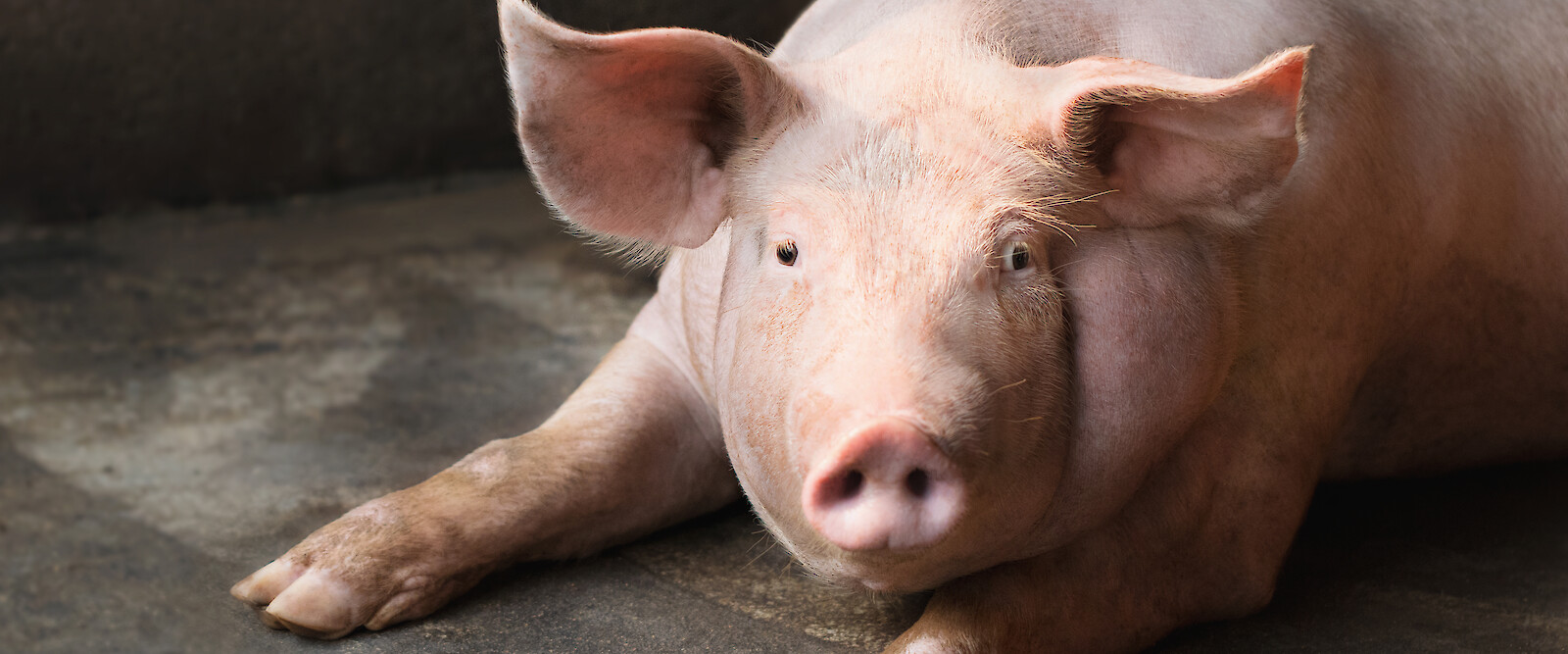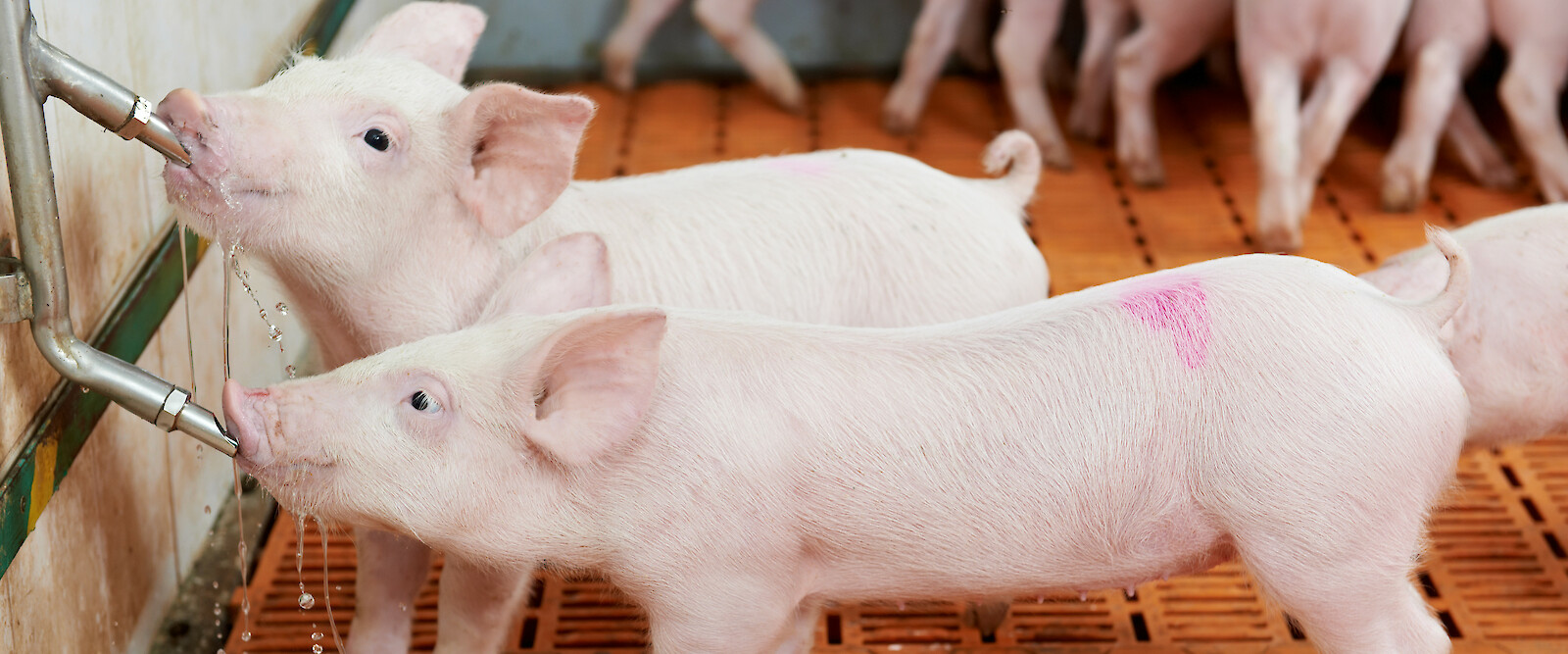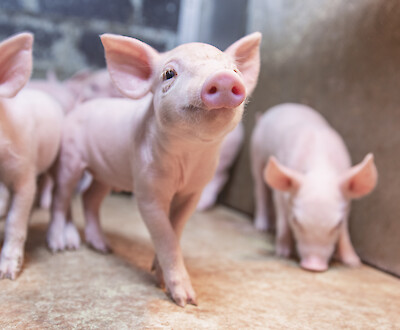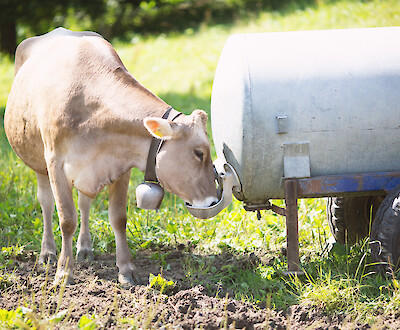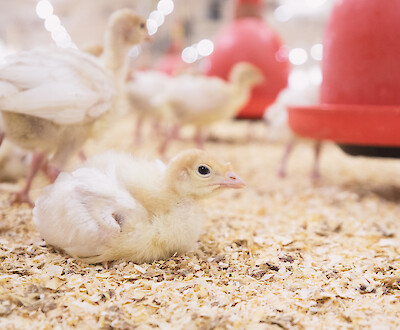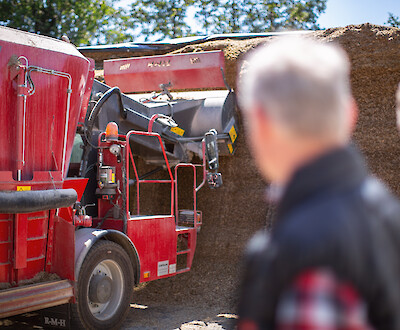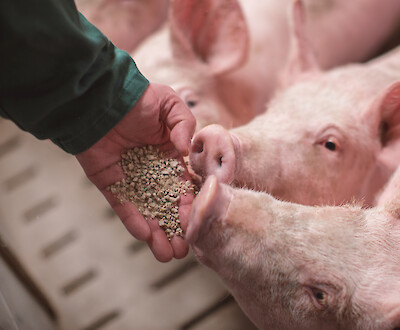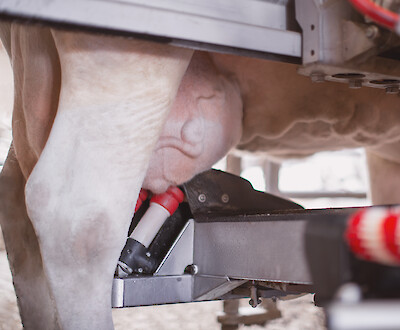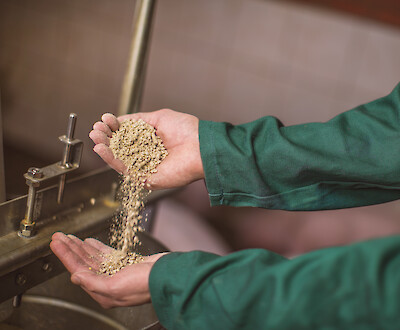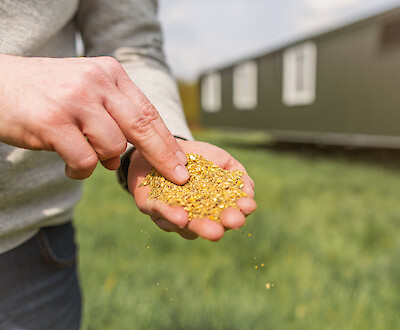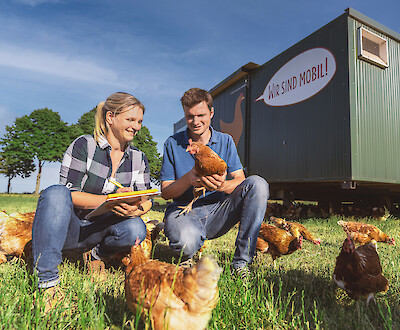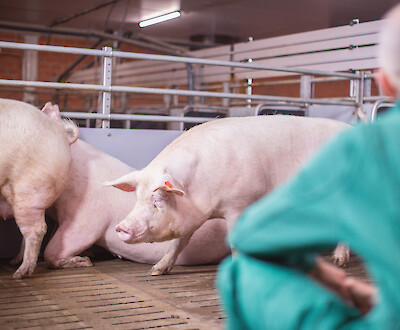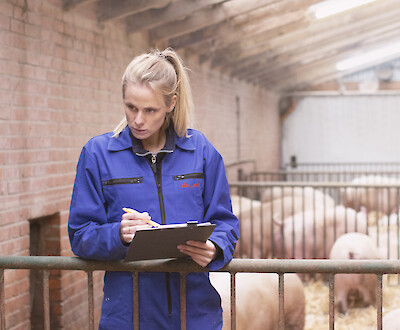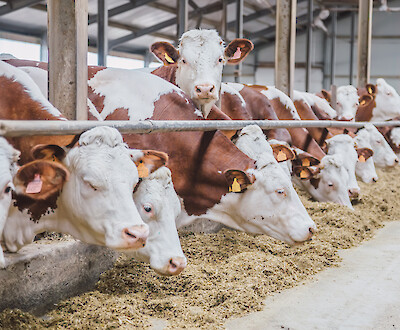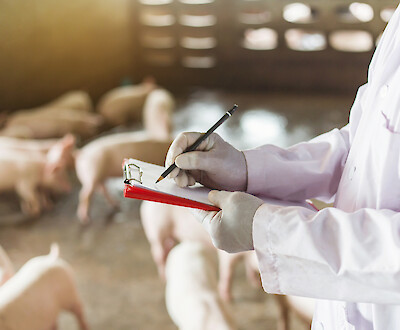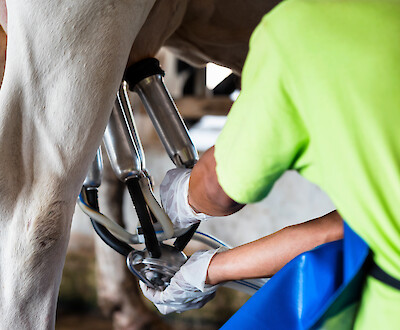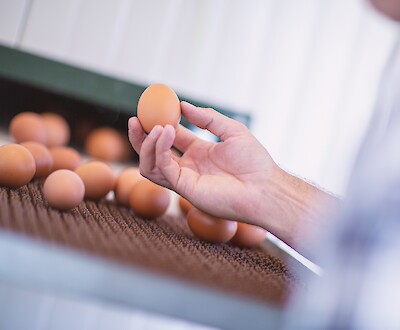Measures against high temperatures in the pig house
Recognize, understand, avoid heat stress in sows, piglets and fattening pigs
Meteorologists are observing increasingly extreme weather conditions in Germany. The number of days with temperatures above 25 degrees has also been increasing for years. The heat in spring and summer is particularly hard on sows and fattening pigs. A decrease in feed intake, reduced milk yield, cannibalism or even the sudden death of animals with poor circulation are possible consequences in heated barns. In the following article, you will learn how to recognize heat stress at an early stage and what measures you can take to reduce the consequences for pigs and the farm.
When does heat stress begin?
Like humans, sows and growing pigs feel most comfortable at moderate temperatures. In this "comfort zone," the animals can maintain their body temperature without additional energy expenditure (piglets: 20-32 °C, sows: 10-20 °C, fattening pigs: 14-26 °C). If outside temperatures rise above this so-called "thermoneutral zone," pigs react sensitively. This is referred to as heat stress. Exactly where this zone lies varies from animal to animal and depends on its age, weight and metabolic performance.
Overview of optimal temperature ranges ("thermoneutral zone") by age class and reproductive stage.
| Stable | Weight (animal/kg) | Optimal air temperature of the stable air (°C) |
| Gilts, empty and pregnant sows, boars | >50 | 10-18 |
| Piglet-bearing sows, zone heating required in piglet area | >100 | 12-20 |
| 20-32* (piglet area) | ||
| Piglets in lying pens on whole-grate floor | 10-30 | 20-26* |
| Fattening pigs including rearing in the clean-out method | 10 | 22-26* |
| 20-30 | 18-22* | |
| 40-50 | 16-20* | |
| 60-100 | 14-18* |
* Air temperature gradually decreasing from the higher to the lower value with increasing age of the animals. (Source: Reiner, G.: Krankes Schwein - kranker Bestand, 2015).
Panting instead of sweating: Behavioral patterns of heat-stressed pigs
Because pigs have almost no sweat glands (only on the trunk disc), they cannot sweat. Thus, they lack an important regulatory mechanism when the heat increases. By panting with their mouths open, the animals try to generate evaporative cooling via the liquid evaporating in the pharynx in order to cool down their organism. Panting is when the animals' respiratory rate leaves the normal range. Sows and fattening pigs breathe an average of 15 to 20 times per minute, while boars only breathe 10 to 15 times. For farmers, breathing rate is a good indicator of heat stress in the herd. With increasing heat, the water requirement of the animals therefore also increases.
Pigs reduce feed intake during heat stress. The digestive and fermentation processes in the gastrointestinal tract convert about 25% of the energy contained in the feed into heat. To reduce this waste heat, sows, for example, eat about 100 g less feed per day from temperatures of 21°C with each degree further temperature rise. At 30°C, this already corresponds to a reduction in the amount of feed consumed of almost 1 kg.
If the temperature in the stall rises, the blood flow to the skin increases due to a widening of the blood vessels. In this way, the animals release more body heat to their environment in order to cool themselves. However, this sensible reaction of the metabolism has an undesirable side effect: the detour of blood to the outer areas of the body (e.g. the legs) can lead to an undersupply of nutrients and oxygen to the intestinal cells. There is a risk of a deficient supply to the stomach and intestines. As a result, the digestive process slows down.
The dilatation of the blood vessels is also a reason why the pigs try to dissipate heat to their environment by lying on a cool surface. The so-called lying down cooling is a central behavior of heat-stressed pigs, which serves to regulate the body temperature. Lying down on metal slatted floors allows them to dissipate heat better than lying on concrete surfaces or plastic slats. Pigs also now prefer to wallow on damp ground to cool off.
5 signs to recognize acute heat stress in the stock
Under the influence of heat, pigs show typical behaviors that farmers can recognize when temperatures are too high. These five signs indicate an acute need for action:
- Reduced feed intake
- Increased water intake
- Shortened, rapid breathing or panting with an open mouth
- Stretched out lying down - preferably on cool or heat-dissipating materials (e.g. metal crevices or damp floor areas)
- Avoidance of body contact with conspecifics
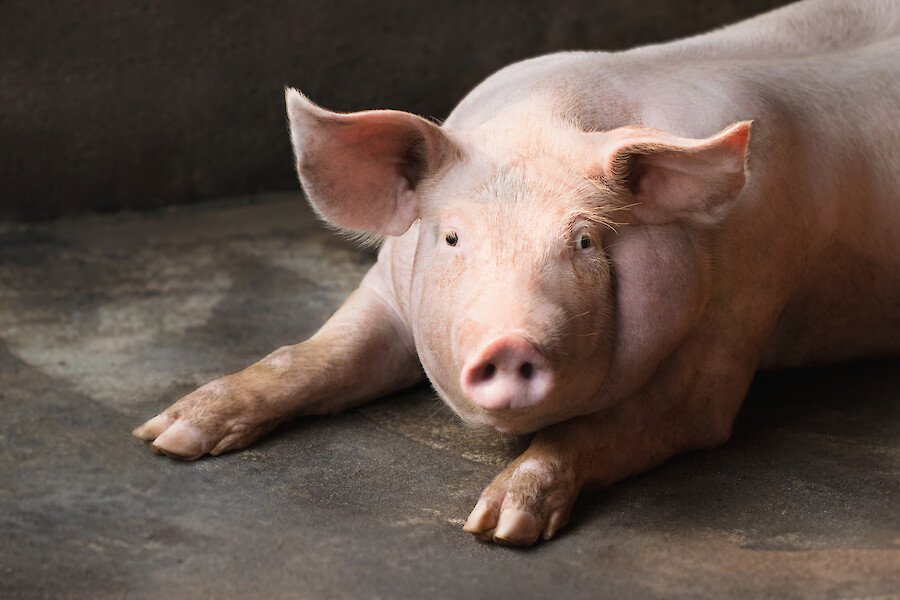
Risks and consequences of heat stress in sows and fattening pigs
-
In pregnant sows, heat stress can reduce the number and survival rate of embryos in low gestation, increase the abortion rate in the middle third of pregnancy, and decrease the number of piglets born alive. Especially the 1st-30th day of gestation and the last two weeks before farrowing are critical periods.
The detour of blood flow to the extremities causes poor supply to the digestive organs during heat stress. This also has a direct impact on sow fertility. Undersupplied cells in the gastrointestinal tract become unbalanced. As a result, they are no longer able to sufficiently neutralize oxygen radicals, which are by-products of the respiratory chain in the mitochondria of each cell. This leads to oxidative stress, and consequently to increased death of intestinal cells. This increases the permeability of the intestinal wall, allowing endotoxins to enter the bloodstream and the uterus. Here, they ultimately jeopardize the implantation of fertilized oocytes in the uterine mucosa.
Fertility can also be negatively affected by a heat-induced low feed intake during lactation. The sow loses more body fat and body condition: less leptin is produced in the adipose tissue - an important signal for the onset of a new flush - so that fertility problems can occur in the next cycle due to rumination.In stressed sows, milk yield decreases during lactation, mainly due to low feed intake. Due to heavy panting, the animals lose more fluid and urinate less. Detoxification via the urine is therefore limited. Toxins that remain in the body increase inflammatory reactions, but also inhibit the formation of the hormone prolactin, which is needed for milk production. The milk shortage threatens supply deficiencies in suckling piglets and reduced weaning weights.
-
Breeding boars are less productive on hot days. Heat stress has a negative effect on the animals' libido and manifests itself in a reduced desire to jump. Sperm quality also suffers due to metabolic stress at high temperatures (from about 27°C). Sows inseminated by heat-stressed boars have, a lower number of fertilized eggs because the semen is damaged by the heat, and increased embryo mortality, so their farrowing rate is lower. This may be one reason why quite a few farms experience fertility problems in spring and summer.
-
The higher the body weight of fattening pigs, the more likely they are to be affected by heat stress. This is the case from 25°C. Heat stress in fattening is manifested by a reduced feed intake and thus results in a prolonged fattening period. Stress and discomfort of the animals as well as economic losses for livestock farmers are the consequence.
The following example illustrates the extent of the stress:
- In a herd with 850 g daily gain and a feed conversion ratio of 2.7:1, approximately 2,300 g of feed are consumed per animal per day.
- If the herd reduces feed intake by only 5% during heat stress, the amount of feed consumed drops to 2,180 g/day.
- In parallel, the daily gain decreases to 807 g/day while feed utilization remains the same. This corresponds to a loss of 43 g per animal per day.
- With a starting weight of 30 kg and a slaughter weight of 110 kg, the fattening period is thus extended from 94 to 99 days.
Does heat stress cause cannibalism?
Heat stress in the herd can promote the occurrence of cannibalism. Stressed sows and fattening pigs are more aggressive than conspecifics in well-climatized barns. The animals' aggressiveness is an important condition for cannibalistic behavior. If the intestinal barrier is damaged as a result of reduced blood flow to the digestive tract typical of heat stress, endotoxins can enter the bloodstream and cause ear margin and tail necrosis. This also promotes cannibalistic behavior.
Measures to avoid heat stress
High outdoor temperatures are the main cause of heat stress. However, body heat generated during digestive processes puts additional stress on the organism. There are major differences in the components that should be taken into account when designing feed rations.
While only 14% of the energy contained in fat is released as heat during digestion, around 25% of the energy in the feed is lost as heat in the case of starch and as much as 38% in the case of protein. This additionally heats up the animals' bodies. It is therefore advisable in spring and summer to reduce the protein content of the ration to the minimum technically necessary and at the same time to obtain the energy rather from feed fat, i.e. to increase the fat content. By evaluating the energy of the ration on the basis of net energy (NE), these aspects are taken into account by additionally including heat losses due to escaping body heat in the evaluation of the feed components - in contrast to the convertible energy, which only takes into account losses from feces and urine. Appropriately protein-reduced, highly digestible feeds are also optimized for praecaecal digestible amino acids. Finally, L-carnitine can be added to increase energy utilization in the feed.
A balanced fiber content in the feed is also important. Fiber keeps digestion going and provides additional energy in the form of short-chain fatty acids through fermentation in the large intestine. This also produces some waste heat. By promoting intestinal peristalsis, fiber nevertheless helps to counteract the slowdown in intestinal transit that threatens to occur in hot conditions. The fermentation capacity of pigs increases with age. For this reason, sows are also able to digest high fiber contents of 6% and more well.
To prevent heat stress-related fertility problems in sows, suitable diets should contain high levels of antioxidant substances and vitamin E. Endotoxin binders (e.g., clay minerals such as bentonite) can bind toxins, preventing them from entering the bloodstream. B vitamins can also help strengthen the immune system. In this way, oxidative stress can be reduced.
Finally, it is recommended to adjust feeding management to counteract heat stress:
- Make sure to offer the feed in more, but smaller portions. In this way, you provide targeted feed stimuli and take into account the animals' reduced appetite.
- Move feeding times to the cooler morning and evening hours, when the animals are more willing to eat. Avoid feeding large amounts of feed in the afternoon. This is when barn temperatures are highest.
- Bacteria and yeasts feel particularly comfortable at warm temperatures. Pay special attention to feed hygiene in summer and clean troughs regularly. If the feed stands in the lines and troughs for too long, feed residues begin to ferment, which reduces the acceptance of the feed.
Water is rightly considered the most important feed. This is all the more true when temperatures are high in spring and summer. Adapted watering management must take account of the pigs' increasing water requirements.
Table 1
| Enclosure section | Live weight (kg) | Water requirement (l/animal/day) | Flow rate (l/min) |
| Suckling piglets |
< 9 |
0,7 – 1 |
0,4 – 0,5 |
| Weaned piglets |
< 30 |
1 – 3,5 |
0,5 – 0,8 |
| Fattening pigs |
< 50 |
3 – 6 |
0,6 – 1,0 |
|
|
50 – 80 |
6 – 8 |
0,8 – 1,2 |
|
|
80 – 120 |
8 – 12 |
1,5 – 1,8 |
| gilts |
|
8 – 12 |
1,5 – 1,8 |
| gushing and low-bearing sows |
|
8 – 15 |
1,5 – 1,8 |
| high-bearing sows |
|
12 – 20 |
1,5 – 1,8 |
| lactating sows |
|
30 – über 50 |
2,5 – 3,0 |
| boars |
|
12 – 15 |
1,0 – 1,5 |
Table 1: Water requirements of pigs in different housing stages at temperatures of 20°C. At temperatures of 30°C and more, the requirement can double. (mod. according to DLG Leaflet 351: "Drinking Technology for Pigs"; © Deutsche Tiernahrung Cremer).
You should ensure the supply of the animals with a drinking technique adapted to the husbandry section. Pigs are sucking drinkers. This means they prefer to take up water from open areas. Water troughs and basin drinkers are therefore particularly suitable for the daily supply. If the installation height is adapted to the animals and the flow rate is set correctly, drinkers that have to be taken into the mouth (e.g. nipple drinkers) are also suitable. Check the water flow and the functionality of the drinkers regularly.
It is imperative to check the water annually for its properties and ingredients. Increased mineral content leads to deposits in the pipes. This prevents unhindered flow and promotes the formation of a biofilm. Both of these factors noticeably reduce the acceptability of the water.
- Request a drinking water check, for example, in our LUFA testing tool to check the water quality on your farm.
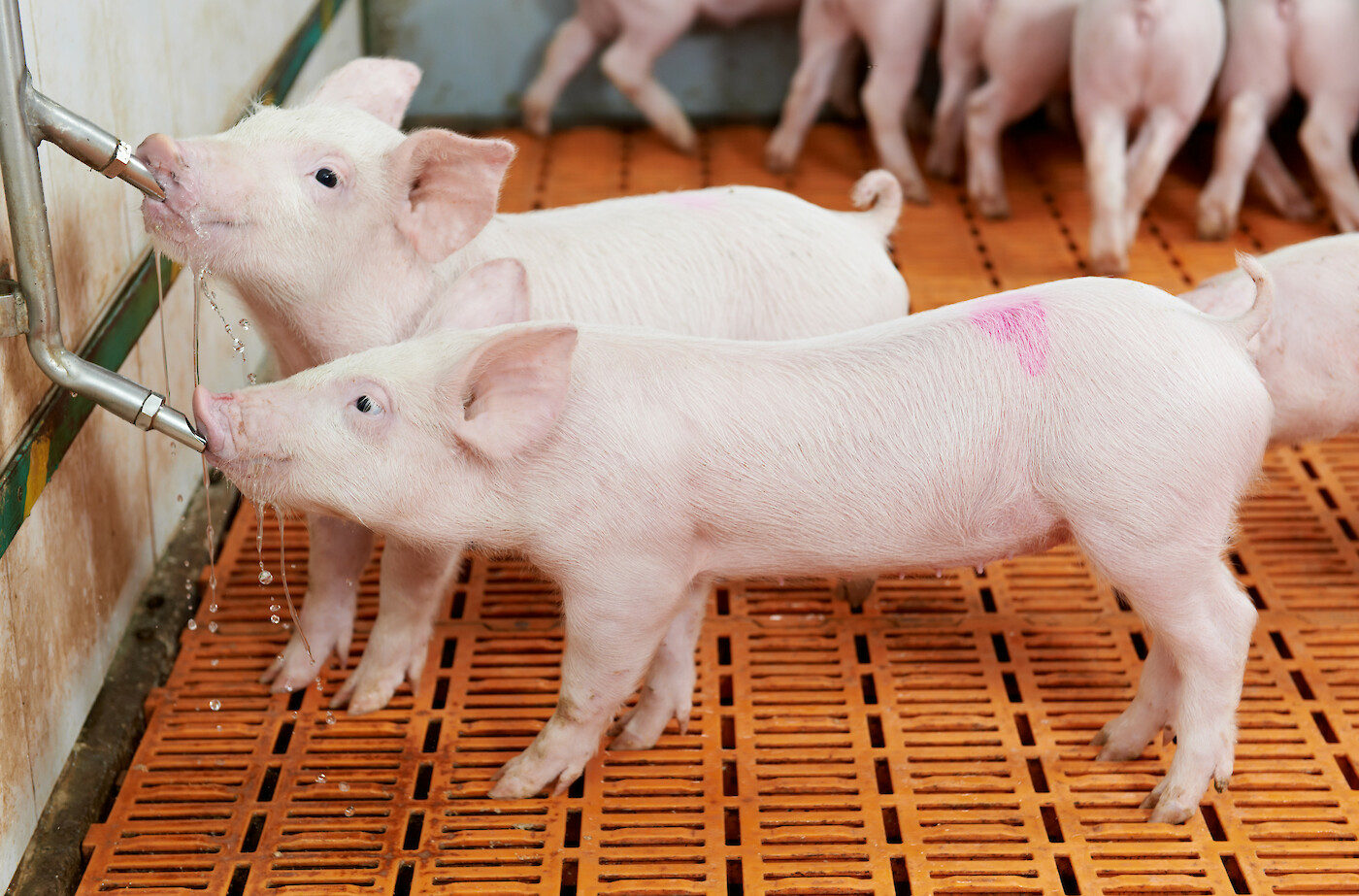
Optimal temperature management starts with the construction of the barn. An orientation along the north-south axis provides many advantages. The barn roofs thus offer little surface for the sun to attack and the buildings heat up less quickly. Light-colored roof coverings, frosted glass windows on the south side and good insulation also keep heat out. Intensify sun protection by planting shade trees and shrubs outdoors.
The heart of climate management in the barn, however, is the ventilation and exhaust systems. Modern ventilation systems can be used to regulate air exchange and indoor temperatures. The intake points for the supply air should ideally be located on the shady north and north-east sides. Ventilation control requires a delicate touch: on the one hand, farm managers must ventilate and cool their barns during the hot months, and on the other hand, they must avoid drafts. While the air speed should not exceed 0.2 m/s in winter, it can be increased to 0.4 m/s in summer for fattening pigs. Otherwise, there is a risk of stress in the stock, as excessive temperature fluctuations between day and night mean stress for the animals. This in turn can promote the occurrence of cannibalism.
Spray cooling can cool down the ambient air inside the barn. Here, fine high-pressure nozzles atomize and distribute water mist in the barn, generating evaporative cooling. This is a cost-effective and efficient way to reduce the temperature in the barn. However, when additionally cooling the pigs with water, care should be taken that the humidity in the barn does not increase too much. Above 20 to 25 °C, high humidity will otherwise cause the pigs to "feel" that it is even hotter than the thermometer would suggest. This is because in sweltering heat, evaporation of moisture through the skin and respiratory tract works less well, as the air is already largely saturated with water vapor. Controlling the temperature in combination with the humidity is therefore crucial for the cooling effect.
Feed concept for heat stress
The evaluation of deuka sow and fattening feed concepts according to net energy and nitrogen-reduced feeding reduce heat production in the body and thus the stress on the organism during heat. Upgrading with high-fat and high-fiber ration components results in a fast and even energy supply without high endogenous heat production. Reducing protein content while providing all essential amino acids as needed minimizes digestive waste heat and decreases gastric pH faster and more effectively. Protein-cleaving digestive enzymes become active at low pH levels, accelerating protein digestion and gastric emptying. This increases feed intake capacity.
The pH reduction in the feed is enhanced by the addition of formic and lactic acids, which also ensure feed hygiene during the critical summer months. The lower pH, combined with the effect of medium-chain fatty acids, also inhibits the effects of pathogenic germs. The precisely balanced content of insoluble fiber stimulates intestinal transit.
- To our feed concepts for sows.
- To our feed concepts for piglets.
- To our feed concepts for fattening pigs.
Conclusion
- Pigs are susceptible to heat stress in spring and summer.
- The thermoneutral zone of pigs varies depending on age, weight and metabolic performance.
- If this comfort zone of pigs is exceeded, the animals suffer from heat stress.
- Heat stress can be recognized by the animals' altered behavior and leads to a number of physiological changes. These reduce the performance of the animals, endanger their health and promote economic losses on the affected farm.
- To avoid heat stress in the herd, farm managers are challenged. A number of measures - from changing the feed, adapting the watering management to building the barn - can help.
Further links
DLG Leaflet 351 "Drinking Technology for Pigs" provides information on water quality and the suitability of various drinking technologies, as well as a checklist for checking water quality and drinking settings.
Further tips on cooling pig houses can be found in the article "Heat stress in pigs: cooling pens effectively" on the website of the Federal Institute for Agriculture and Food.
Image sources: © krumanop – stock.adobe.com (Top-Slider) / © Kadmy – stock.adobe.com
Contact person

Contact person


